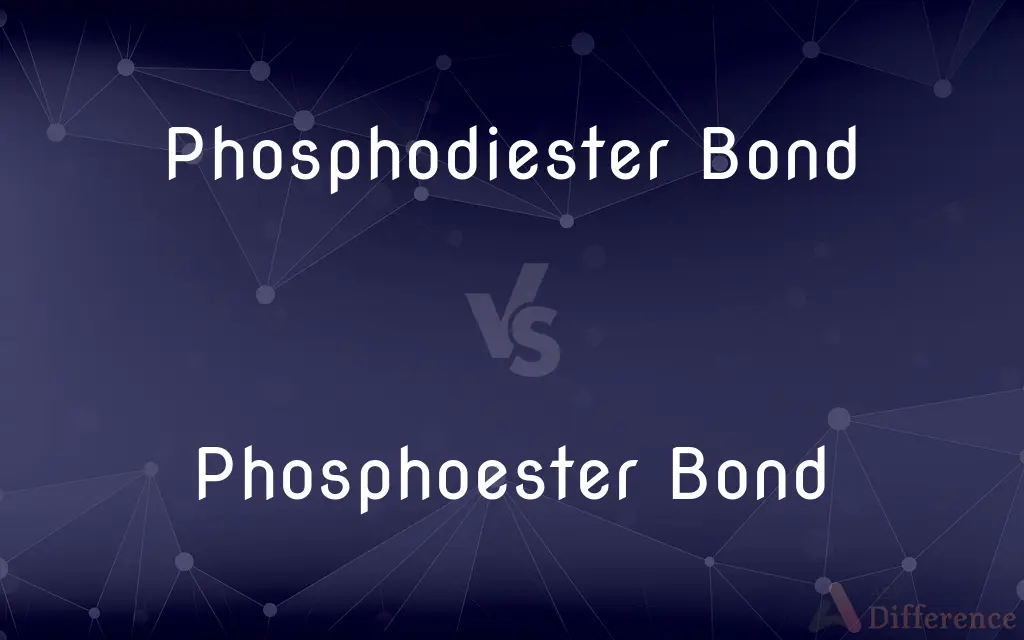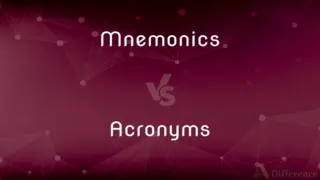Phosphodiester Bond vs. Phosphoester Bond — What's the Difference?
By Tayyaba Rehman — Published on November 20, 2023
Phosphodiester bonds link the 3' carbon of one nucleotide and the 5' carbon of another in DNA/RNA, involving two ester bonds, while phosphoester bonds involve a single ester bond, connecting a phosphate group to a hydroxyl group in molecules.

Difference Between Phosphodiester Bond and Phosphoester Bond
Table of Contents
ADVERTISEMENT
Key Differences
Phosphodiester bonds, paramount in the structure of nucleic acids, facilitate the linkage of nucleotides in DNA and RNA strands, essentially crafting the backbone of these fundamental biological macromolecules. In contrast, phosphoester bonds, involving a singular linkage, establish connections between a phosphate group and a molecule through one ester bond, laying down a simpler structural formation compared to the dual connections exhibited by phosphodiester bonds.
In DNA, phosphodiester bonds are crucial, acting as a bridge between the 3' carbon atom of one sugar molecule and the 5' carbon atom of another, enabling the creation of the sugar-phosphate backbone integral to the stability and structure of the nucleic acid. Phosphoester bonds, however, are often seen within single molecules, such as when a phosphate group is connected to a single alcohol group, therefore providing a less complex structural scenario compared to the overarching connectivity showcased by phosphodiester bonds.
The resilience and stability of the phosphodiester bond lie in its robust linkage, protecting the genetic information in the nucleic acid chains from enzymatic degradation under normal biological conditions. Oppositely, phosphoester bonds, with their solitary linkage, might exhibit a somewhat less stable configuration, as the singular bond may be more prone to hydrolytic attack, indicating a potentially differential stability between the two bond types.
It's worth noting that phosphodiester bonds play an indispensable role in processes like DNA replication and RNA synthesis, ensuring the accuracy and integrity of genetic information transfer across generations. In the realms of biochemistry where phosphoester bonds find application, the utility might revolve around processes involving phosphorylation or other instances where a single linkage to a phosphate group suffices, revealing different functional significance attached to each bond type.
Furthermore, the role of the phosphodiester bond extends to its participation in events like DNA repair, thereby safeguarding genomic fidelity. Meanwhile, phosphoester bonds, while perhaps not directly analogous in function, can be found in various biochemical contexts, such as the construction of certain biomolecules or metabolic pathways, implying that while both bond types are pivotal, they command distinctly separate roles in biological systems.
ADVERTISEMENT
Comparison Chart
Number of Ester Bonds
Two
One
Involvement in Nucleic Acids
Fundamental in forming nucleic acid backbones
Not directly involved
Stability
Relatively stable due to two ester linkages
Potentially less stable with a single linkage
Functional Role
Integral in DNA/RNA structure and genetic information
Found in phosphorylation and metabolic pathways
Hydrolytic Stability
More resistant to hydrolysis
Comparatively susceptible to hydrolysis
Compare with Definitions
Phosphodiester Bond
A linkage between nucleotides in nucleic acids.
The phosphodiester bond connects nucleotides in the DNA backbone.
Phosphoester Bond
May exhibit susceptibility to hydrolytic cleavage.
Phosphoester bonds can be hydrolyzed under certain conditions.
Phosphodiester Bond
Involves connections between the 5' and 3' carbons of nucleotides.
A phosphodiester bond forms between the 3' carbon of one nucleotide and the 5' carbon of another.
Phosphoester Bond
Occurs within certain biochemical molecules and processes.
Phosphoester bonds can be found in some molecules involved in metabolic pathways.
Phosphodiester Bond
Demonstrates resistance to enzymatic cleavage.
The stability of the phosphodiester bond is vital for maintaining DNA integrity.
Phosphoester Bond
Not directly implicated in forming nucleic acid backbones.
Unlike phosphodiester bonds, phosphoester bonds do not form the backbone of DNA.
Phosphodiester Bond
Integral in processes like DNA replication.
Phosphodiester bonds ensure the continuity of the DNA strand during replication.
Phosphoester Bond
Involves a single bond connecting a phosphate and hydroxyl group.
A phosphoester bond is created when a phosphate group binds to an alcohol.
Phosphodiester Bond
A bond featuring two ester bonds.
The phosphodiester bond utilizes two ester bonds to link nucleotides.
Phosphoester Bond
Represents a single ester linkage.
The phosphoester bond contains a single ester linkage between molecules.
Common Curiosities
Can a phosphoester bond link nucleotides?
No, nucleotides are typically connected by phosphodiester bonds.
How many ester bonds are in a phosphoester bond?
A phosphoester bond contains one ester bond.
Is a phosphodiester bond involved in RNA structure?
Yes, phosphodiester bonds form the backbone of RNA.
Are phosphodiester bonds integral to genetic information transfer?
Yes, they play a crucial role in maintaining and transmitting genetic information.
Which bond type provides greater stability in nucleic acids?
Phosphodiester bonds provide enhanced stability in nucleic acids.
Do phosphodiester bonds resist hydrolysis?
Yes, phosphodiester bonds are relatively resistant to hydrolysis.
What connects a phosphate group and an alcohol in molecules?
A phosphoester bond connects a phosphate group and an alcohol.
Are phosphodiester bonds present in both DNA and RNA?
Yes, phosphodiester bonds are present in both DNA and RNA.
Are phosphoester bonds implicated in nucleic acid structure?
No, phosphoester bonds are not directly involved in forming nucleic acid structures.
What connects nucleotides in DNA?
Phosphodiester bonds connect nucleotides in DNA.
Where might phosphoester bonds be found?
Phosphoester bonds may be found in various biochemical molecules and processes.
Can a phosphoester bond link two nucleotides?
No, linking two nucleotides typically involves a phosphodiester bond.
Can a phosphoester bond form between nucleic acid bases?
No, a phosphoester bond does not form between nucleic acid bases.
What facilitates the formation of a phosphodiester bond?
A condensation reaction facilitates the formation of a phosphodiester bond.
Are phosphodiester bonds susceptible to regular enzymatic cleavage?
No, phosphodiester bonds are quite stable and resist regular enzymatic cleavage.
Share Your Discovery

Previous Comparison
Mnemonics vs. Acronyms
Next Comparison
Clonazepam vs. DiazepamAuthor Spotlight
Written by
Tayyaba RehmanTayyaba Rehman is a distinguished writer, currently serving as a primary contributor to askdifference.com. As a researcher in semantics and etymology, Tayyaba's passion for the complexity of languages and their distinctions has found a perfect home on the platform. Tayyaba delves into the intricacies of language, distinguishing between commonly confused words and phrases, thereby providing clarity for readers worldwide.













































